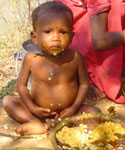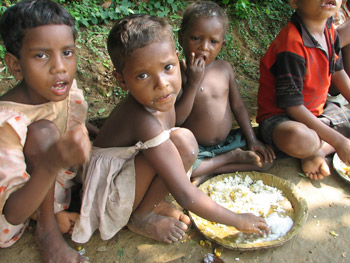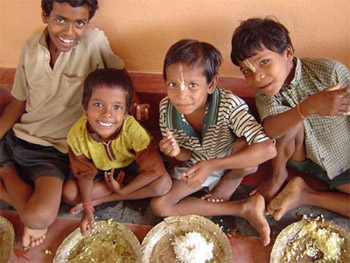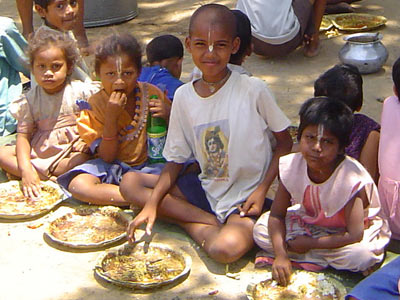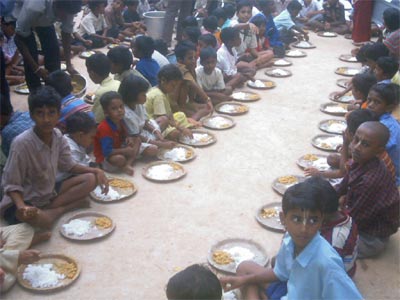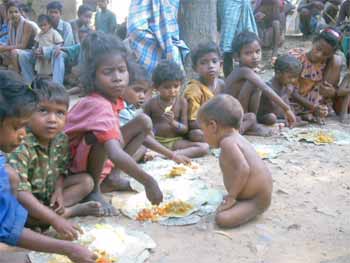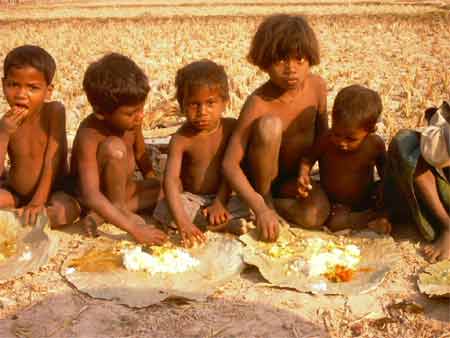[ Originally posted on August 18th, 2001 ]
The water level in Batarani river system is rising due to heavy rainfall in some parts of the coastal districts. Fresh warning for evacuation has been issued to Bhadrak and Jajpur district. Most of the areas in these districts are now submerged in water. As there was no time to repair the breaches, the fresh attempt to Kharif paddy is frustrating and in some areas it is unlikely to revive.
The extent of the damage is as follows (source: Govt of Orissa)
Death toll: 100
Flood affected population: 9.678 million
Districts affected: 24
Number of Blocks affected: 218
Number of Panchayats affected: 2757
Number of villages affected: 18790
Number of breaches occurred: 1396
Number of Cattle lost: 18149
Houses Damaged: 250615
Crop loss: 9 million hectares
Crop loss estimated: 14.83 million USD
However detail assessment of Govt is under process
Impact of the disaster:
Flood in coastal areas of Orissa has affected more than 9.678 million population.
The crop loss of paddy and few non-paddy is over an area of 0.891 million hectares. As per the Government estimate, only 68% of the targeted paddy area could be covered. Twenty five percent of the paddy areas were severely affected by recurrent floods.
Water and sanitation in more than 10000 villages has been badly hit.
Water sources are affected in 215 blocks and 1628 G.Ps and the number of tube wells affected is 27203.
Health services have been badly hit due to flooding of 235 health centres. Reports of water-borne diseases are being received from Govt control room, NGOs and National UN Volunteer Doctors.
As per the Disease surveillance cell report as on 16.08.2001
Health Situation Cases Deaths
Diarrhoeal cases 4423 1
Suspected malarial 3720 0
Acute jaundice 14 0
Snake Bite 17 0
On the day Diarrhoeal cases detected 2878(65%) suffers from Simple Diarrhoea, 1334(30.2%) suffered from Bacillary / Bloody Dysentery and 211(4.8%) suffered from Severe Diarrhoea.
Feeding programme through the ICDS centres is badly hit due to flooding in the villages. It is estimated that 197 Anganwadi Centres (feeding centres for Children) are damaged.
Educational institutions have also been hit and classes suspended in affected areas.
Crop damage (100%) due to flood is in 136 Blocks of the State affecting more than 4 million population.
Breaches formed in the embankments, submerged land masses, landslide, washed away bridges /Culvert have obstructed major road communication
Flood in coastal Orissa and flash flood in western Orissa has caused 27,000 ha land not suitable for cultivation due to heavy sand-casting. The most affected are Kalahandi, Bolangir, Boudh, Angul, Sambalpur, Dhenkanal, Cuttack etc.
Flood in the coastal district leading to damage in fishery sector is as follows.
No. & Area Of Tank Damaged: 27,148 nos.&9899.25 ha.
No. Of Hatchery Damaged: 7 nos
No. Of Fishermen Affected: 76,540 nos
No Of Net Damaged: 25,070 nos
No of Boat damaged: 4,354 nos
Diseases are spreading among cattle, which has caused many deaths. Livestock affected in blocks-131, G.Ps-1393 & village-8435. Total livestock affected are 4,280,417 and casualty figure in respect of Cattle-5319, Sheep-3706, Goat-2555, Buffalo-505, Pig-296, Poultry- 12485 and total is 24866.
Government action:
Containment measures progressed till date is as follows:
1st, 2nd and 3rd rounds of disinfecting wells have been done. Total number of wells disinfected is 428458; patients treated are 92516; contacts treated are 27529; minor ailments treated are 586528.
Progressive tube wells repaired is 7207; disinfected 71772 out of affected total 27203 & rural pipe water restored 112 out of 122.
Total number of doctors deployed for the treatment of patient in the affected areas is 285, paramedical 149, attendant 22.
Cattle feed of 4081 MT and rice born 58.2 MT has been supplied to districts.
Out of 4280417 livestock affected 310458 animals had been treated and preventive vaccination was done in 743540 cases.
Free Kitchen arrangements in 399 centres under which 109454 beneficiaries had been provided.
People affected by sand-casted land have not received any support for their livelihood from any corner. No concrete measures have been taken for removal of sand in the areas that could be brought back to cultivation after suitable treatment.
To assess the damage caused by flood a central team will visit the state for 3 days from August 23rd.
OSDMA is conducting weekly meeting with NGOs, UN agencies and Government. The following were discussed in the meeting held on 14.08.2001:
Need for the assessment of livelihood in the aftermath of flood situation.
Mapping of vulnerable points on river embankments, communication links, locations of villages and shelters to each GPs of affected district to be prepared on priority basis.
UN observes this year, as International Year of Volunteers, thus there is need for data bank of volunteers to meet the disaster situations in future.
MD, OSDMA suggested for documentation of human stories both from government and NGO sector for guidance in future.
The documentation on people’s response and lessons learnt on the present flood will be ready shortly.
UN agencies action:
UNDP with the assistance from DFID/CHAD is implementing livelihood restoration programme in the flood-affected districts through NGOs and CBOs. Agricultural inputs (seeds, seedlings, pesticides, small implements) and service support for agriculture will be provided to 10000 beneficiaries @ Rs 2400 per family. MoUs with the NGOs/ CBOs has been signed and the first instalment has been released to them.
UNDP had sent a team to assess the situation of sand casting and options for livelihood for the affected families in Bolangir district and final report is awaited.
W.H.O has established contact with State health control room and daily disease surveillance reports are being received and response analysed.
To strengthen the disease surveillance system during the crisis, W.H.O with NGOs partnership supported team of doctors/ volunteers who provided health services in the cut-off areas.
UNDP with request from Government of Orissa is supporting family emergency kits for the flood-affected population. Bharat Gyan Vigyan Samiti (BGVS) will do ten thousand numbers of emergency family kits for the distribution. Need assessment for vulnerable families and procurement of family kits is being done by BGVS. This is supported by OCHA.
UNICEF has provided support for printing of health, water and sanitation IEC messages and they are being distributed through Govt departments and also through NGOs and NUNVs.
Essential drugs have been supplied and support for drinking water has also commenced already.
WFP had deployed a logistic expert to support OSDMA in management of relief goods and developing a warehousing strategy.
WFP has provided 1236 MT Of CSB/India Mix.
WFP is in the process of using generated funds toward the purchase of non-food items to assist the rehabilitation of the ICDS project.
FAO supplied agricultural inputs-paddy seeds to 3200 families under the ongoing FAO-TCP beneficiaries and have been a great support to the affected population in these areas.
While UNICEF is planning to strengthen delivery of normal programmes in the affected districts, WFP is intending to develop an understanding with partner NGOs for food for development in the affected districts.
Click here to view the attached International Agencies table (pdf* format)
Major issues:
1. The districts affected by floods are also the cyclone-affected districts and livelihood restoration for about 4 million will be a major concern.
2. Three successive disasters in the state have virtually shaken the confidence of the people and any intervention by the Govt and civil society will have to be more holistic than project driven. It implies therefore that even the restoration exercise will have to extend beyond a normal time frame.
3. Breach closing and strengthening of embankments through peoples participation programme is urgent both in term of saving productive agricultural land, livelihood support and ownership responsibility of the creative asset.
4. Areas affected by sand-cast in western Orissa needs livelihood/agriculture support, as the crop(s) in these areas are being affected consecutive three years either by drought and/or flash flood.
5. Strengthening social safety nets for the affected population will have to be on top of the agenda, if large-scale migration in the forth-coming pre-rabi/rabi season is to be prevented.
6. Will the restoration exercise lead to higher degree of preparedness among the community, Government and civil society organizations?
7. Exploring wider role for civil society organisations for reaching the unreached communities in view of the incongruence between the resource availability and existing delivery mechanisms.
8. Crisis prevention and recovery will have to be integral and a frontal activity in all-developmental programmes from now on.

